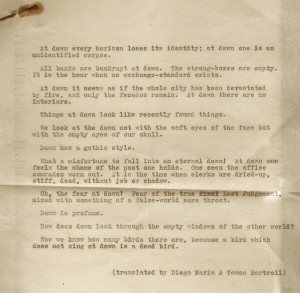Found in a box of papers – this two page typewritten carbon copy of a  poem entitled ‘The Dawn’ by the famous Spanish experimental writer Ramón Gómez de la Serna translated into English by Diego Marin ( author of Poesia Espanola, 1962) and Tomas Bartroli (fl. 1969). It would be interesting to discover its provenance.
poem entitled ‘The Dawn’ by the famous Spanish experimental writer Ramón Gómez de la Serna translated into English by Diego Marin ( author of Poesia Espanola, 1962) and Tomas Bartroli (fl. 1969). It would be interesting to discover its provenance.
In his time Gomez (1888 – 1963) was arguably the most celebrated experimental writer in Spain. Born in Madrid to a middle-class family, he refused to follow his wealthy father into law and politics, resolving instead to adopt the bohemian lifestyle of an experimental writer, and subsequently he began contributing to many of the avant-garde magazines of the period.
Like Sartre in Paris, years later, he established a literary salon in Madrid’s Café Pombo and during the First World War brought out six collections of experimental poems—El Rastro, El Doctor Inverosimil, Greguerias, Senos, Pombo and El Circo. Thereafter he continued to publish experimental writing, including works on Dali and El Greco. His work strongly influenced the surrealist film-maker Luis Bunuel. He is now best known for his lapidary ‘ greguerias’.
One source has described his main characteristics as a writer thus:
‘ his search for a new fragmentary genre of short prose poems, his exaltation of trivial everyday objects, his emphasis on eroticism, his exuberant self-projection and exclusive dedication to art, his playful humour, his contemplative secular mysticism, and above all his cut of the image…’
He has justifiably been compared with Joyce and Proust and his admirers include Octavia Paz and Pablo Neruda
As has been noted, Gomez wrote on Dali, and he has been described as a surrealist, but although superficially ‘Dawn’ seems to have features in common with surrealist poems of the twenties and thirties, it is not strictly surrealist in style. Most of the statements that make up the poem rely for their effect on simile and metaphor:
‘On the earth’s bridge the train of dawn is vibrating. The artillery of dawn is heard’
‘At the lakes, the dawn stays looking and nothing more. There is nothing as static as this moment’
Or
‘At dawn it seems as if the whole city has been devastated by fire, and only the facades remain. At dawn there are no interiors’
Or
‘Dawn is profane.’
But at times genuinely surrealist images coexist with metaphor, as in
‘At dawn death can answer a telephone call’, which recalls to mind Dali’s ‘Lobster Telephone’.
Or even
‘Oh, the fear at dawn! Fear of the true Last Judgement, mixed with something of a false-world sore throat.’
However, when those images that are so common in Surrealist painting appear –for instance, the skull and the corpse—they don’t exert the power that they might do in, say, a work by Dali. In fact, though he refers to ‘recently found things’, which is a concept taken from surrealist art, most of the images used by de la Serna are strongly redolent of expressionist and symbolist art. The facades in his city devastated by fire, for instance, could be those of the de Chirico, as could ‘the train of dawn’ and the streets of Moscow, ‘ which are streets of a cold colour dedicated to death’. The image of the mirror too is more likely to be found in symbolist or expressionist art than in Surrealism.
Today, Gomez is most admired for the early prose poems of the First World War, which are rare and highly sought after. However, a glance at abebooks.com will confirm that he is still popular in Spain. Outside his native land, however, his books don’t seem to have been widely translated into English. Luckily for us, ‘ Dawn’ is one that has been. {RR}


What a find! Thanks for putting this up. I have some of his ‘greguerias’ (lapidary is good)